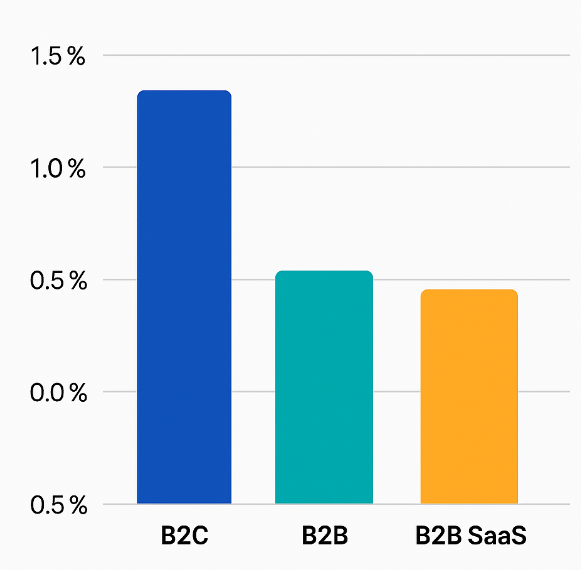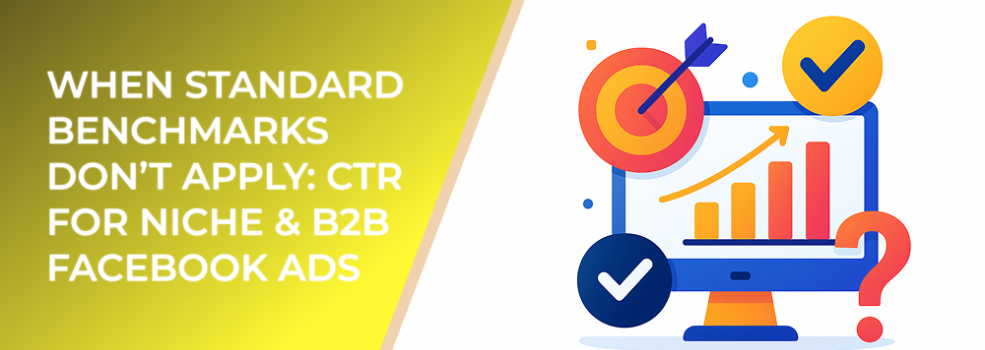When marketers look up Facebook Ads performance averages, they typically see a general range — 0.9% to 1.5% CTR across industries. However, this number often reflects consumer-focused (B2C) campaigns where the audience is broad, products are visual, and engagement is easier to drive.

Average Facebook ad CTR: B2C benchmarks vs. B2B general and B2B SaaS in 2025
For niche industries and B2B campaigns, the situation is different. Target audiences are smaller, buying cycles are longer, and decisions are driven by information, not emotion. These factors naturally lower engagement rates, making traditional benchmarks unreliable for comparison.
According to Wordstream’s 2024 report, the average CTR for B2B ads is around 0.78%, compared to 1.6% for e-commerce and 1.2% for travel. The gap doesn’t necessarily indicate poor performance — it reflects different audience intent.
Understanding CTR in a Niche or B2B Context
A lower CTR doesn’t automatically mean your ads aren’t effective. In B2B marketing, a small number of clicks from the right decision-makers can be far more valuable than hundreds of irrelevant clicks.
Several factors influence CTR in these environments:
-
Audience Size and Precision
Niche targeting limits reach. You’re often advertising to professionals, companies, or specific job titles — not the general public. This focus lowers total impressions but increases lead quality. -
Ad Type and Offer Complexity
B2B ads often promote whitepapers, demos, or consultations instead of quick purchases. Users may engage differently, clicking fewer but more intentional times. -
Decision-Making Timeline
B2B buyers research over weeks or months. Ads may generate multiple touchpoints before a click or conversion occurs. -
Creative Constraints
B2B offers rarely allow for flashy visuals. Ads must balance professionalism and clarity, which can limit spontaneous engagement.
What to Use Instead of Generic CTR Benchmarks
Instead of comparing your CTR to consumer industries, focus on relative and contextual performance:
-
Historical Benchmarks: Compare new campaigns to your past performance under similar conditions.
-
Engagement Quality: Measure lead quality, time on page, or conversion rate rather than just CTR.
-
Funnel Position: CTR will vary across the funnel — top-of-funnel ads typically perform higher, while bottom-of-funnel ads focus on conversion.
-
Competitor Performance: Use Facebook’s “Auction Insights” or analyze competitors’ ad activity in your industry to understand realistic expectations.
For example, if your B2B ad gets a 0.6% CTR but drives qualified leads at 20% conversion, it’s outperforming a 1.5% CTR e-commerce ad with unqualified traffic.
How to Improve CTR for B2B and Niche Ads
While lower CTRs are natural, several strategies can still boost engagement:
1. Use Precise Targeting With Broader Interest Layers
Combine job titles or industries with related interests or behaviors. For instance, target “marketing directors” but include interests like “growth strategy” or “CRM software.”
2. Simplify the Message
B2B audiences value clarity. Avoid jargon and lead with a tangible benefit or insight. Ads that summarize value in 10 words or less often outperform those with long explanations.
3. Test Thought-Leadership Creatives
Educational or insight-driven ads often perform better than direct sales messaging. Use headlines that promise expertise — for example: “5 Proven Ways to Cut SaaS Costs.”
4. Use Retargeting Wisely
Since most B2B buyers don’t convert immediately, retargeting campaigns can significantly increase total CTR over time. Use tools like LeadEnforce to build custom audiences based on website visits or engagement, ensuring consistent follow-up.
5. Refresh Visuals Frequently
Ad fatigue happens even in narrow audiences. Swap visuals every few weeks to maintain visibility and interest.
When a Low CTR Still Means Success
CTR doesn’t always measure intent. A 0.5% CTR in a B2B SaaS campaign that reaches executives could still generate valuable leads if each conversion is high-value. It’s better to judge campaigns by lead cost and conversion quality rather than by CTR alone.
In LeadEnforce’s client data, B2B campaigns often show 30–40% lower CTRs than B2C, but deliver up to 2.5x higher ROI because the traffic is better qualified.
Final Thoughts
Benchmarks are only useful when compared to similar campaigns. For niche or B2B industries, a lower CTR doesn’t reflect poor performance — it reflects precision. The goal isn’t to attract every click, but the right ones.
When you focus on intent, value-driven creative, and long-term engagement, your campaigns can outperform standard metrics in impact — even if they don’t in raw numbers.

